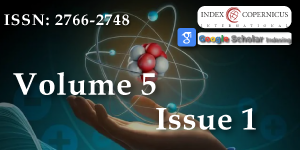Oscillation of neutrino in a vacuum with mixing flavor
Main Article Content
Abstract
We developed multiple equations to observe the two and three flavors of neutrino oscillation with the mixing angle based on L/E=0.1 to 0.9 in this study. In diff erent settings, the nature of the neutrino oscillation probability was discovered to be varied in diff erent equations. The observation indicates increasing likelihood in one equation and decreasing probability in the other equations in two flavor oscillation neutrinos. To characterize the probability of neutrino oscillation, we use four distinct angles: 50 , 100 , 150 , and 200 . The probability of neutrino oscillation was determined to be highest at an angle of 150 degrees. However, with increasing mixing angles, the likelihood of oscillation increases on the basis of created equation (25) and decreases on the basis of equations (26) and (27) in the three-flavor neutrino oscillation. From generated equations (25) and (26) the maximum neutrino oscillation of probability is discovered at an angle of 150, however, from equation (27), the maximum probability is observed at 50. The greatest neutrino oscillation is found to be 0.9999 and the minimum is zero in all of these two and three flavors of oscillation.
Article Details
Copyright (c) 2022 Koirala B, et al.

This work is licensed under a Creative Commons Attribution 4.0 International License.
The International Journal of Physics Research and Applications is committed in making it easier for people to share and build upon the work of others while maintaining consistency with the rules of copyright. In order to use the Open Access paradigm to the maximum extent in true terms as free of charge online access along with usage right, we grant usage rights through the use of specific Creative Commons license.
License: Copyright © 2017 - 2025 |  Open Access by International Journal of Physics Research and Applications is licensed under a Creative Commons Attribution 4.0 International License. Based on a work at Heighten Science Publications Inc.
Open Access by International Journal of Physics Research and Applications is licensed under a Creative Commons Attribution 4.0 International License. Based on a work at Heighten Science Publications Inc.
With this license, the authors are allowed that after publishing with the journal, they can share their research by posting a free draft copy of their article to any repository or website.
Compliance 'CC BY' license helps in:
| Permission to read and download | ✓ |
| Permission to display in a repository | ✓ |
| Permission to translate | ✓ |
| Commercial uses of manuscript | ✓ |
'CC' stands for Creative Commons license. 'BY' symbolizes that users have provided attribution to the creator that the published manuscripts can be used or shared. This license allows for redistribution, commercial and non-commercial, as long as it is passed along unchanged and in whole, with credit to the author.
Please take in notification that Creative Commons user licenses are non-revocable. We recommend authors to check if their funding body requires a specific license.
1. Kruppke D. On Theories of Neutrino Oscillations. Diploma Thesis. 2007
2. Kopp J. Phenomenology of Three-Flavour Neutrino Oscillations. Physik-Department. Technische Universitat Munchen.2006.
3. Gonzalez-Garcia MC, Yokoyama M. Neutrino Masses, Mixing, and Oscillations. Physical Review D. 2018; 98:6-9.
4. Nunokawa H. Neutrino Mass, Mixing and Oscillations. Brazilian Journal of Physics. 2000; 30(2):346-356.
5. Upadhyay A, Batra M. Phenomenology of Neutrino Mixing in Vacuum and Matter. ISRN High Energy Physics. 2013.
6. Thomson M. Handout 11: Neutrino Oscillations. Lecture Note.2011.

